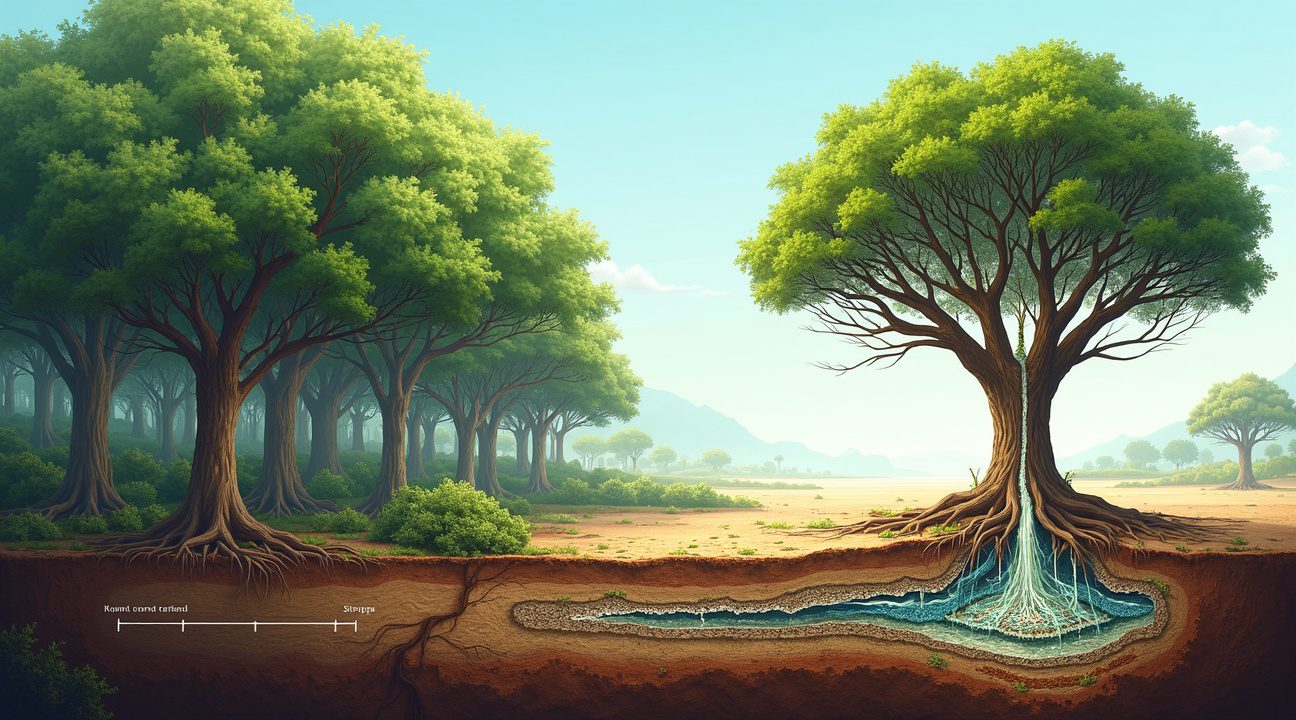Kenyan fig trees have transformed scientific understanding of carbon sequestration by developing an extraordinary ability to convert atmospheric CO₂ into permanent calcium carbonate deposits within their trunks and surrounding soil.
Key Takeaways
- Kenyan fig trees utilize the oxalate-carbonate pathway to convert atmospheric CO₂ into calcium carbonate crystals, forming permanent stone-like deposits within their trunks that do not decompose or release carbon back into the atmosphere.
- AI satellite mapping detected nearly 10 billion trees across sub-Saharan Africa’s drylands, storing an estimated 840 million metric tons of carbon. Individual trees store between 63–98 kg of carbon depending on the climatic conditions.
- The calcium carbonate formation involves a symbiotic process among trees, soil bacteria, fungi, and termites, resulting in stable mineral compounds that persist in the environment for thousands of years.
- Mineral-based carbon storage presents superior climate benefits when compared to traditional wood-based methods, as these deposits remain locked away permanently, unaffected by decomposition even after the trees die.
- Carbon-mineralizing fig trees offer dual functionality by producing nutritious fruit for sustainable agriculture, while also permanently sequestering carbon and enhancing soil alkalinity to promote better crop yields.
For more on this innovative natural method of carbon sequestration, explore related research at the Nature Communications journal, which details the ecological and biochemical processes behind the carbon-to-stone conversion in Kenyan fig trees.
Kenyan Fig Trees Convert Atmospheric CO2 Into Permanent Stone Storage
I find it remarkable that certain fig tree species native to Kenya have developed an extraordinary ability to transform atmospheric carbon dioxide into solid limestone-like rock formations. This process represents a revolutionary form of carbon capture that goes far beyond what scientists typically observe in forest ecosystems. Unlike traditional trees that store carbon in wood, leaves, and other organic materials, these Kenyan fig trees permanently lock away CO₂ by converting it into calcium carbonate within their trunks and surrounding soil.
The Oxalate-Carbonate Pathway Explained
The fig trees accomplish this stone-forming process through what researchers call the oxalate-carbonate pathway. I observe that this biochemical mechanism allows the trees to transform gaseous CO₂ into solid mineral deposits that can persist for centuries or even millennia. The trees absorb atmospheric carbon dioxide through their leaves during photosynthesis, but instead of converting all of it into organic compounds like cellulose or sugars, they channel a portion through specialized metabolic pathways that produce calcium carbonate crystals.
This calcium carbonate formation occurs both within the tree’s trunk tissues and in the soil around its root system. The process creates microscopic limestone deposits that become embedded in the tree’s structure, effectively turning portions of the living wood into stone-like material. Scientists have documented this phenomenon most extensively in Samburu County, where specific fig species demonstrate this unique carbon mineralization capability.
Superior Carbon Storage Compared to Traditional Methods
The stone-forming process offers several advantages over conventional biological carbon storage methods. Traditional trees store carbon in organic forms that eventually decompose and release CO₂ back into the atmosphere when the tree dies or sheds leaves. However, the calcium carbonate created by these Kenyan fig trees remains stable for much longer periods because inorganic minerals don’t break down through biological decay processes.
This permanent sequestration method provides several key benefits:
- Carbon remains locked away even after the tree dies, unlike organic carbon storage
- The mineral deposits resist degradation from weather, insects, and microbial activity
- The process continues throughout the tree’s lifetime, creating cumulative stone deposits
- The surrounding soil also becomes enriched with stable carbonate minerals
The implications for climate change mitigation could be substantial if scientists can better understand and potentially replicate this process. While researchers continue studying these remarkable trees, the discovery has already sparked interest in whether similar mechanisms might exist in other plant species or could be enhanced through selective breeding programs.
The fig trees in Samburu County represent just one example of how nature continues to surprise scientists with innovative solutions to environmental challenges. Much like how scientists think they’ve discovered unexpected mechanisms in human cognition, these trees demonstrate biological processes that challenge our understanding of how plants interact with atmospheric carbon. The discovery adds another layer to our appreciation of how diverse ecosystems contribute to global carbon cycling in ways we’re only beginning to comprehend.
Research teams continue monitoring these fig trees to quantify exactly how much carbon they convert to stone annually and whether environmental factors influence the mineralization rate. Early findings suggest that trees in areas with higher calcium availability in the soil produce more extensive carbonate deposits, indicating that soil composition plays a crucial role in this remarkable carbon-to-stone transformation process.

How the Revolutionary Oxalate-Carbonate Pathway Transforms CO2 Into Rock
The oxalate-carbonate pathway represents a groundbreaking discovery that challenges everything scientists thought they knew about carbon storage in nature. This process starts with standard photosynthesis, where trees capture atmospheric CO₂ just like any other plant. However, what happens next sets these African trees apart from every other carbon-storing organism on Earth.
After photosynthesis captures the carbon dioxide, these remarkable trees convert a portion of that carbon into calcium oxalate crystals within their tissues. I find this initial transformation fascinating because it marks the beginning of what becomes a permanent carbon lock-up system. The calcium oxalate crystals form naturally within the tree’s cellular structure, creating the foundation for the extraordinary process that follows.
The Collaborative Network That Creates Stone
The real magic happens when specialized soil bacteria, fungi, and sometimes termites enter the equation. These organisms work together to convert the calcium oxalate into calcium carbonate—the same mineral compound found in chalk and limestone. This collaboration creates a living laboratory where biological processes manufacture geological materials in real-time.
The calcium carbonate doesn’t just disappear into the soil. Instead, it accumulates in two critical locations:
- Deep within the tree’s woody structures, becoming permanently embedded in the trunk
- Throughout the surrounding soil, creating mineral-rich deposits that persist for centuries
- Along root systems, where the highest concentrations of microbial activity occur
Scientists have discovered that this process significantly increases soil alkalinity while potentially improving nutrient availability for surrounding vegetation. The transformation essentially creates a feedback loop where trees improve their own growing conditions while simultaneously removing carbon from the atmosphere permanently.
What makes this pathway truly revolutionary is its permanence. Regular photosynthetic pathways store carbon in organic forms that eventually decompose and release CO₂ back into the atmosphere. The oxalate-carbonate pathway sidesteps this limitation entirely by converting carbon into inorganic mineral deposits that remain stable indefinitely.
This sequestration method isn’t universal across all tree species. Current research indicates it’s limited to specific varieties like the Kenyan fig, though scientists suspect other African species may possess similar capabilities. The discovery has opened new avenues for understanding how some ecosystems have developed natural carbon capture systems that operate far beyond conventional biological processes.
The implications extend beyond simple carbon storage. This pathway represents a sophisticated biological system where plants, microbes, and insects collaborate to transform atmospheric gases into permanent geological formations, essentially turning trees into living factories that manufacture stone from thin air.
Massive Scale of African Tree Carbon Storage Revealed by AI Mapping
Revolutionary satellite technology combined with artificial intelligence has unveiled a breathtaking discovery across sub-Saharan Africa’s drylands. I’ve observed how this groundbreaking study identified nearly 10 billion individual trees scattered throughout these vast regions, fundamentally changing our understanding of carbon storage in Africa.
These remarkable trees exist predominantly outside traditional dense forests, thriving in areas previously overlooked by conservation scientists. The research revealed an astounding carbon stock of approximately 0.84 petagrams—equivalent to 840 million metric tons of stored carbon. This massive repository represents a previously unrecognized component of Africa’s carbon cycle.
Climate Zone Variations in Carbon Storage
The study uncovered fascinating variations in carbon storage capacity based on climate conditions. Trees in different zones demonstrate remarkable adaptability in their carbon sequestration abilities:
- Arid regions: Trees store an average of 63 kg of carbon per individual
- Semi-arid zones: Carbon storage increases significantly in these moderate conditions
- Sub-humid areas: Trees reach peak storage capacity at 98 kg per individual
Advanced AI algorithms processed thousands of satellite images to map each tree individually, creating an unprecedented database of dryland vegetation. This technology enabled researchers to distinguish between different tree species and measure their carbon storage potential with remarkable precision.
Previous carbon models had consistently miscalculated the contributions of scattered dryland trees. Some estimates were too high, while others dramatically underestimated the carbon-sequestering power of these isolated giants. The new findings have corrected these inaccuracies, providing a more reliable foundation for climate change mitigation strategies.
The ecological importance of these discoveries extends far beyond carbon storage. Scientists studying unique forest ecosystems recognize how individual trees in drylands create microhabitats that support diverse wildlife populations. Each tree acts as an oasis, providing shade, nutrients, and shelter in otherwise harsh environments.
Africa’s vast drylands now represent a critical frontier in global carbon management. The ability of these trees to trap carbon and convert it into stone-like structures within their trunks offers a permanent solution to atmospheric carbon dioxide removal. Unlike other carbon storage methods that can release CO2 back into the atmosphere, this natural mineralization process locks carbon away indefinitely.
The implications for climate policy are profound. Protecting and expanding dryland tree populations could significantly contribute to global carbon reduction goals while simultaneously supporting local ecosystems and communities. This research demonstrates that effective carbon sequestration doesn’t require dense forests—individual trees scattered across Africa’s drylands are quietly performing one of nature’s most important climate services.

Stone Storage vs Traditional Wood Storage: A Revolutionary Difference
Traditional carbon sequestration operates through well-understood biological processes where trees absorb atmospheric CO₂ and convert it into organic compounds. These compounds become part of the tree’s structure – wood, leaves, bark, and roots – storing carbon for decades or sometimes centuries. When trees die or decompose, this stored carbon eventually returns to the atmosphere through natural decay processes.
The Organic Carbon Cycle
Most tree species worldwide follow this conventional pattern of carbon storage. Forest ecosystems capture significant amounts of atmospheric carbon, but the storage remains temporary in geological terms. Wood can preserve carbon for 50 to 200 years under optimal conditions, while leaf litter and smaller organic matter release their carbon much faster. This cycle has supported forest-based climate strategies globally, though scientists have long recognized its limitations regarding permanent carbon removal.
The Revolutionary Stone Formation Process
Kenyan fig trees operate through an entirely different mechanism that transforms atmospheric carbon into mineral form. These remarkable trees utilize the oxalate-carbonate pathway to convert CO₂ into calcium carbonate – essentially limestone – within their trunk tissues and surrounding soil. This process creates permanent carbon storage that persists on geological timescales.
The mineral formation occurs when the trees produce calcium oxalate crystals, which then react with carbonic acid to form stable calcium carbonate deposits. These stone-like formations remain locked within the tree structure and don’t decompose like organic matter. Research suggests this storage method can preserve carbon for thousands of years, representing a fundamental shift from temporary biological storage to permanent geological sequestration.
This oxalate-carbonate pathway exists in very few plant species globally, making it an exceptionally rare natural phenomenon. While traditional forest carbon storage depends on preventing deforestation and maintaining healthy forest ecosystems, stone-forming trees offer something entirely different – they actively remove carbon from the atmosphere and lock it away permanently.
The implications for climate action are substantial. Traditional reforestation projects must account for eventual carbon release when trees die or forests burn. Stone-forming trees eliminate this concern by converting atmospheric carbon into stable mineral compounds that won’t return to the atmosphere through natural processes.
Scientific discoveries continue to reveal new aspects of how these trees function differently from conventional species. The calcium carbonate deposits form continuously throughout the tree’s lifetime, creating an ongoing carbon removal system that operates independently of forest management practices.
This revolutionary difference positions stone-forming trees as a unique tool for permanent carbon removal, distinct from traditional forest-based climate solutions that provide temporary storage.

Game-Changing Implications for Climate Solutions and Sustainable Agriculture
Fig trees have emerged as revolutionary players in climate science, representing the first documented fruit-bearing species capable of significant inorganic carbon sequestration. Unlike traditional carbon storage methods that rely on organic matter susceptible to decay and release, these remarkable trees convert atmospheric CO₂ into calcium carbonate crystals—essentially turning carbon into stone within their trunks. This process creates a permanent carbon lock that can’t be reversed through decomposition or fire, making it far more reliable than conventional organic carbon storage.
Transforming Agricultural Systems Through Climate-Smart Forestry
The discovery of Kenyan figs’ dual functionality opens unprecedented opportunities for sustainable agriculture. Farmers can now cultivate trees that simultaneously provide nutritious fruit harvests while actively combating climate change through permanent carbon sequestration. This represents a fundamental shift from viewing trees merely as crop producers to recognizing them as active climate solution partners. Agricultural systems incorporating these carbon-mineralizing species could achieve dramatically enhanced long-term climate mitigation compared to traditional monoculture approaches.
Climate-smart agroforestry using these specialized trees offers several compelling advantages:
- Permanent carbon storage that remains stable for decades or centuries
- Continued food production without sacrificing environmental benefits
- Enhanced soil alkalinity that improves nutrient availability for surrounding crops
- Reduced dependency on external carbon offset programs
- Diversified income streams through both fruit sales and potential carbon credits
Ecosystem Enhancement and Soil Transformation
The soil transformation occurring around these carbon-sequestering trees creates cascading benefits throughout agricultural ecosystems. As trees convert CO₂ into calcium carbonate, the surrounding soil becomes increasingly alkaline, fundamentally altering the chemical environment in ways that enhance nutrient availability. This natural soil conditioning reduces the need for synthetic fertilizers while supporting healthier plant growth across entire farming systems.
Scientists have observed that this soil alkalinization process supports broader ecosystem services beyond simple pH adjustment. Enhanced nutrient cycling, improved water retention, and increased microbial activity all contribute to more resilient agricultural landscapes. These changes create positive feedback loops where healthier soils support more vigorous tree growth, leading to accelerated carbon mineralization rates.
Strategic selection of tree species with high inorganic carbon capture potential could revolutionize how agricultural communities approach climate resilience. Rather than viewing climate action as separate from food production, farmers can integrate carbon-sequestering trees directly into their production systems. This integration offers immediate economic benefits while building long-term climate adaptation capacity.
The stability of calcium carbonate storage makes this approach particularly attractive for developing comprehensive climate strategies. While organic carbon storage remains vulnerable to environmental fluctuations, the stone-like carbon deposits created by these trees provide guaranteed permanence. This reliability could support more aggressive climate commitments from agricultural sectors traditionally hesitant to embrace carbon offset programs due to uncertainty about long-term storage effectiveness.
Research into similar carbon-mineralizing species continues across different ecological zones, suggesting that this phenomenon may be more widespread than initially recognized. Scientists are investigating whether other discoveries in natural systems might reveal additional species with comparable capabilities. The potential for developing agricultural systems that actively reverse atmospheric carbon accumulation while maintaining productive food systems represents one of the most promising developments in climate science and sustainable agriculture.

Sources:
ScienceBlog.com: “Fig Trees Turn Atmospheric Carbon Into Stone”
Discover Magazine: “Some Fig Trees Can Turn CO2 Into Stone”
Phys.org: “Fig trees convert atmospheric CO₂ to stone, research reveals”
University of Zurich (GIUZ): “Fig trees convert atmospheric CO₂ to stone”
NASA: “NASA-Funded Scientists Estimate Carbon Stored in African Dryland Trees”
Nature: “Sub-continental-scale carbon stocks of individual trees in African drylands”
INRAE: “A groundbreaking study reveals the carbon stocks of 10 billion trees in the drylands of sub-Saharan Africa”


